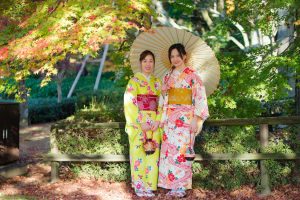If you’ve ever admired the elegant flow of a kimono or the casual charm of a yukata, you’ve likely noticed the beautiful sash that completes the look. This sash is called an obi, and it plays a crucial role in Japanese fashion and culture.
A Brief History of the Obi
The obi has a long and storied history in Japan. Originally, it was a simple and functional piece of cloth used to hold the kimono or yukata closed. However, as time passed, the obi evolved into a significant fashion statement and symbol of social status.
Early Beginnings
In the Heian period (794–1185), the obi started as a thin belt known as a koshi-himo. It was primarily functional, designed to keep the garments in place. By the Edo period (1603–1868), the obi began to grow in width and complexity, reflecting the wearer’s social standing and fashion sense.
The Modern Obi
Today, the obi is much more than a simple belt. It can be several meters long and vary widely in style, color, and fabric. There are even specialized obi for different occasions, such as formal events, festivals, and casual outings.
The Role of the Obi in Attire
The primary function of the obi is to keep the kimono or yukata securely closed. However, it also serves as a decorative element that adds flair and elegance to the outfit.
Different Types of Obi
- Fukuro Obi: This is a formal obi often worn at weddings or other special occasions. It is usually made from luxurious fabrics such as silk and features intricate patterns.
- Nagoya Obi: A more casual obi, perfect for everyday wear. It is easier to tie and typically shorter than the fukuro obi.
- Hanhaba Obi: This is a narrower and more informal obi, often used with yukata. It is simple to tie and ideal for casual occasions.
Colors and Patterns
The colors and patterns of an obi can signify various things, including the wearer’s age, marital status, and even the season. For example:
- Bright, vibrant colors are often worn by young, unmarried women.
- Subdued, elegant tones are more suitable for older or married women.
- Seasonal patterns, such as cherry blossoms for spring or maple leaves for autumn, are also popular choices.
How to Tie an Obi
Tying an obi can be an art form in itself. There are many different knots and styles, each with its own cultural significance. Some popular methods include:
- Taiko Musubi: Also known as the “drum knot,” this is a classic and formal style often seen at ceremonies and formal events.
- Bunko Musubi: A simpler knot often used with yukata, perfect for casual outings.
- Tsuke Obi: A pre-tied obi that is convenient and easy to wear, ideal for beginners.
Why the Obi Matters
The obi is more than just a sash; it is a symbol of Japanese culture and aesthetics. Whether you’re donning a kimono for a traditional tea ceremony or wearing a yukata to a summer festival, the obi completes your outfit and connects you to a rich cultural heritage.
Understanding the significance and history of the obi can deepen your appreciation for Japanese fashion and culture. Whether you’re a Japan lover, a fashion enthusiast, or a cultural explorer, the obi offers a fascinating glimpse into the artistry and tradition of Japan.
Ready to explore the world of obis? Learn how to tie an obi and much more with our detailed guides and expert tips.





